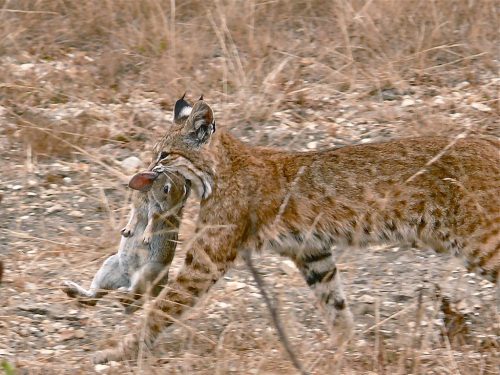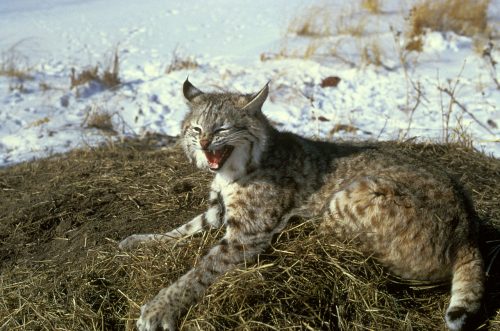In Divining with Animal Guides, I write about three momentous encounters with Mountain Lions, but I have also had encounters with the smaller wild cousin of the Mountain Lion, the Bobcat.
One of the things I like best about the Bobcat is that she doesn’t view me potentially as food. She is much too shy and small. The Bobcat is about twice the size of a kitty cat and weighs 20 pounds on average. She has tufts of fur on her ears like a lynx and a short tail that is the source of her descriptive name. Her fur ranges from tawny yellow to gray and her spots may be prominent or indistinct.

The Bobcat will run away rather than stand her ground with a human and is therefore rarely seen. The ubiquity of Bobcat tracks in the Adirondacks assure me that the population here is robust. I’ve seen a Bobcat in the Adirondacks in the middle of the day, in winter, though she is supposedly nocturnal. She was standing in a forested area along a highway. In the Sonora desert we did think of Bobcats as night animals, because they would creep into housing areas late at night, drinking from swimming pools and hunting domestic cats.
My best close-up encounter with any wild cat happened in the daytime in Arizona with a Bobcat. The house I lived in had a glass sliding door that opened onto a brick paving area, too small to be called a patio, with a spigot on one side. The Bobcat was drinking leisurely from the shallow well under the spigot. My cat Misha alerted me to the Bobcat’s presence by crying and pacing in front of the door. Misha and I sat in front of the glass watching the Bobcat for about five minutes, Misha’s tail wagging furiously the whole time. Certainly the Bobcat was aware of us sitting there, not even three feet away, with Misha crying, but she acted like we were invisible, or at least unimportant. I was surprised that Misha didn’t run away. Apparently both cats understood how doors work.

To me, one of the symbolic issues of the Bobcat has to do with deception. We hear so much more about the big cats – lions, cougars, leopards, panthers, jaguars – and even the Canada Lynx, only slightly bigger than the Bobcat, attracts more interest. It’s easy to dismiss the Bobcat, but the Bobcat is the wild cat most likely to be skulking around the margins of your experience.
